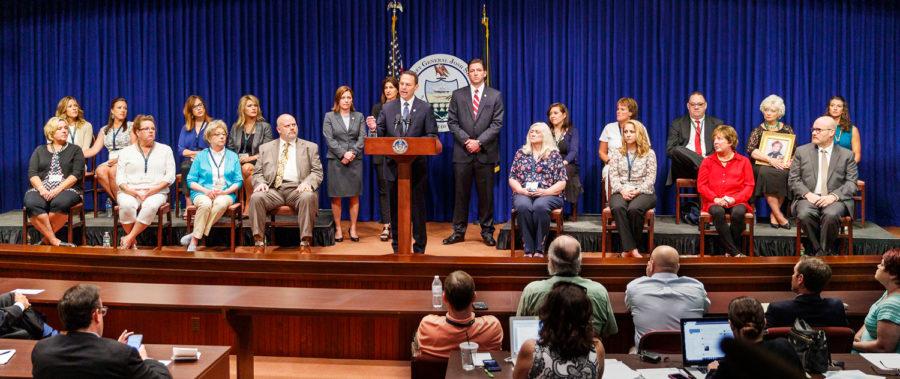Editorial | Ruling protecting priest anonymity unfair to victims
(Michael Bryant/Philadelphia Inquirer/TNS)
Pennsylvania Attorney General Josh Shapiro, center, speaks on the findings of the grand jury report on child sexual abuse in six Catholic dioceses at the State Capitol, with 16 victims or family members of victims of sexual abuse by Catholic priests seated on stage with him on Aug. 14.
December 6, 2018
Pennsylvania’s Catholic dioceses is no stranger to sexual assault allegations. A grand jury released a report in August detailing the sexual abuse of more than 1,000 minors committed by more than 300 Catholic clergymen, 11 of whom had their names redacted.
On Monday, the Pennsylvania Supreme Court voted 6-1 to keep those 11 priests anonymous.
“[The ruling] is a victory for all Pennsylvanians,” Justin Danilewitz, an attorney who represented many of the priests in August’s grand jury report, said. “Victims can take comfort … that their voices were heard, but not at the expense of innocent individuals.”
But the decision is only a victory for serial sexual abusers and self-interested church officials. It completely denies victims the justice they deserve and erases the network of accountability the Catholic Church desperately needs to bring assailants to justice.
According to the Pennsylvania Supreme Court, releasing the alleged abusers’ names would unfairly tarnish their reputations, a “fundamental individual human right” protected by the state constitution.
But the court’s decision doesn’t provide any solutions to the rampant sexual abuse within the Catholic Church. The grand jury report was originally intended to not only shed light on a decades-old scandal, but to also encourage other victims to report their horrific experiences and change the law to accommodate victims.
Shaun Dougherty testified before the Altoona-Johnstown jury on abuse that allegedly occurred over the span of three years when he was only 10 years old. He’s now 48, far exceeding Pennsylvania’s statute of limitations.
“If this doesn’t start a serious debate on the elimination of the statute of limitation, there’s something seriously wrong with my fellow Pennsylvanians,” Dougherty said before the grand jury.
Testimonies like Dougherty’s certainly worked. Not only did dozens more alleged victims come forward, but the wave of reports was startling enough to nearly change the statute of limitations. In October, the Pennsylvania House proposed a two-year window where victims of priest molestation could press charges no matter when the incident allegedly happened.
While the bill didn’t pass, it was a positive first step toward validating the victims. The second step is justice. If the government can’t legally reveal the priests’ names, the diocese can and certainly should.
“I call on the bishops to do so immediately, consistent with their recent calls for transparency,” Attorney General Josh Shapiro said after the ruling.
Sexual abuse is a crime that needs to be handled by the courts, but the church’s involvement in concealing perpetrators has allowed this systematic abuse to continue for decades.
Until the church itself changes its attitude toward the rampant priest molestation happening within its own ranks, allegations will continue to be swept under the rug — cementing the Catholic church as a safe haven for predators, not innocent children.








